The SEO industry will always vary according to trends, and the rise of AR will definitely be course-changing for the SEO specialists and their content strategies.
An emerging field of technology, augmented reality or AR seems to be somehow of a buzzword nowadays. Rumor has it that augmented reality is limitless and has enormous potential, holding plenty of features in the store for the future. Should the SEO hark to these facts?
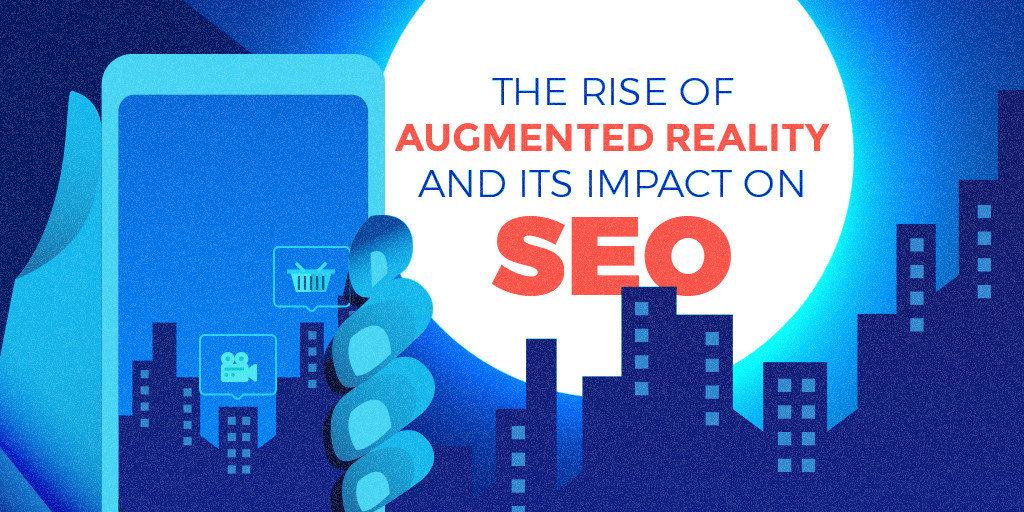
We took the challenge of talking about augmented reality and the impact on SEO and show you the connection between them. But that’s not all. Gain deep insight and an overall view on the topic by following each tab from the table of contents below:
- The Rise of Augmented Reality and What You Missed About It
- When and Where Augmented Reality and SEO Connect
- Augmented Reality and Local SEO
- What Do Experts Say About Augmented Reality and SEO
- Google and Augmented Reality
- Facebook and Augmented Reality
- Snapchat and Augmented Reality
- Apple and Augmented Reality
- What to Do Next Instead of Conclusion
Steve Jobs said once: “You’ve got to start with the customer experience and work back toward the technology – not the other way around”. Today there’s a new level of consumer power. Search marketers and SEOs strive to follow trends and market changes in order to retain customers.
And the rise of augmented reality can be both the wave that takes you out to greatness, and the breath of fresh air to upgrade your marketing game.
This is true especially when AR is dependent on content, the very core of digital marketing, SEO, SEM, and of everything a business sends out to the crowd. Content is king again. Content is a must-have, translated both as the message displayed inside the AR experience and as a trigger for retaining audiences. That is why FinTech and SEO race to be early adopters.
1. The Rise of Augmented Reality and What You Missed About It
What Exactly Is AR?
Using the means of digital technology, augmented reality overlays information in video, text, or image format onto everyday surroundings, objects, and locations from the real world.
Gaia Dempsey, co-founder of DAQRI, makes it clearer for everyone what AR is and looks like by summarizing everything in the video below:
| 80% of the information that the brain takes in is visual; so by providing information in a visual medium that also has the spatial nature of augmented reality, you’re giving the brain a very intuitive way of accessing knowledge. | |
 |
Gaia Dempsey |
| Co-founder @DAQRI/ daqri.com | |
Users will normally acknowledge the augmented reality around them by making use of a smartphone camera, tablet, goggles, or headset specially designed for AR. Still, for the time being, AR is mostly stuck on the smartphone (be it made available by brands, or used by audiences across the globe) and will have limited use cases, such as education, gaming, social media, and indoor mapping.
Although very promising, AR devices don’t appeal yet to a very large mass of consumers, but find a home more in the work industry, especially in the blue-collar environment.
There are two versions of AR technology: marker-based (which uses a visual, physical trigger to start the AR experience), and markerless-based (it doesn’t need a trigger to start an AR experience, rather it builds the experience from scratch).
In other words, AR can fall into three categories:
- Information overlay (e.g. The British Museum where you can scan a displayed object and pop-up messages will appear with info regarding that specific object);
- Virtual objects (e.g. Ikea refurbishing homes – scan your home, then place different pieces of furniture in your house environment to see how they fit);
- Digital packaging (e.g. Pepsi, Coca Cola, or Starbucks using AR interfaces designed by Layar and Blippar).
Marker-based augmented reality regards real life objects that trigger virtual activity and visuals. All you need is a proper device, which for the common user and for most of the times is the camera.
Enter Spider-Man's world in augmented reality! Simply scan special General Mills products using Blippar app to unlock this exclusive #AR experience #SpiderManHomecoming(Participating products, available only in USA)
Posted by Blippar on Tuesday, June 27, 2017
When Did AR Start to Become a Thing?
The world started talking about AR once the Pokemon Go phenomenon began to spread in 2016. Everyone went crazy; firstly, for the concept itself; secondly, for the thrill and engagement it provided.
Since then, many businesses have opted for building apps and interfaces that employed features of AR. Some of them are Pokemon Go, Snapchat, Google Translate, Star Chart, Pepsi, and a whole lot more, to name just a few.
But things hold a lot more than they show. In fact, augmented reality is not a novelty at all.
The AR technology was actually developed in the ’60s by Morton Heilig, yet from then it has made huge leaps in matters of improvement.
Heilig’s invention displayed a huge device called sensorama, one of the earliest known examples of multimodal technology. Sensorama was able to display stereoscopic 3D images using a wide-angle view, employ body tilting, provide stereo sound, and also had the necessary means for wind and aromas to be triggered during the film.
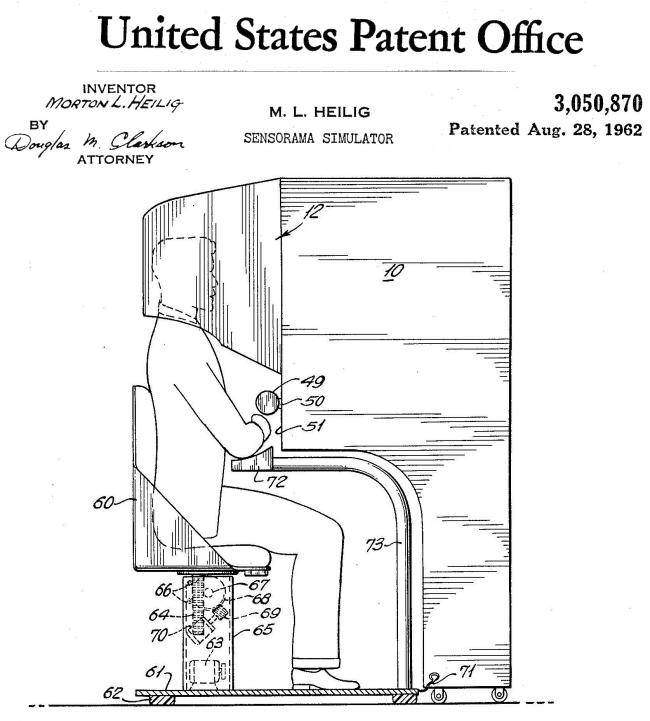
Which Are the Impacted Industries
Statistically speaking, eCommerce will be the most impacted industry of all. Imagine virtually trying out shoes from your favourite brand without the hustle and bustle of actually doing it all day long, running from one shop to another. Brands like Adidas and Converse have already tried this technology, scoring higher conversion rates, yet fewer returns, once customers satisfied their necessity or curiosity.
With the help of augmented reality shopping and marketing, eCommerce is and will be able to gain more powerful insight and feedback from customers. Reviews, star ratings, how many times something was tried out, social shares, try-out span, and a whole lot more information will be at the brands’ disposal.
GAP and hardware chain Lowes are already using augmented reality and VPS (Virtual Positioning System) to suit their customers’ needs and exceed their expectations. GAP opted in for a “no physical try out needed anymore”, similar to that of Adidas’ and Converse’s. Lowes came with this bright idea of an AR app for your shopping list, where you can get real-time directions inside the store to know where and if you can find the product you noted on the list.
The Difference Between AR and VR
Augmented reality and virtual reality often go hand in hand. It’s not uncommon for AR or VR to be mistaken by beginners. The thing is that both AR and VR allow you to experience computing more than you could do just from working, playing, or interacting with a computer. They both either bring computing to your world or take you to a new world, but resembling the real one.
Unlike augmented reality, virtual reality (VR) provides a totally immersive experience in a world that is created from scratch, with little to no connection with the real world. VR does generate realistic images, sounds, and other sensations, but the imagery environment is virtual and artificial, computer-generated.
VR uses mostly comprise gaming, but can also be relevant for entertainment causes such as seeing movies, sports games, shows or concerts, health care, manufacturing industry, education, military, and even NASA duties.
If we are to relate to the list above, there’s not much of a difference between AR and VR when it comes to use case environments either. Yet unlike VR, AR is totally geo-point bound with no to very little independence from location or object.
International Data Corporation (IDC) made a forecast on the worldwide spending on AR and VR for 2017 and 2020. They estimate the augmented reality and virtual reality market to reach $13.9 billion by 2017, an increase of 130.5% over the spending recorded in 2016. As for 2020, the spending is estimated to be $143.3 billion.
When doing a quick check on mentions across the web and social media, we see that AR and VR are becoming more and more a trend talk. They get traction. Be it because virtual reality games or augmented reality apps gain popularity at a fast pace or not, BrandMentions displayed actionable clear cut results worth taking into account.


Although augmented reality leads the mention race, VR doesn’t fall too short, as it closely follows AR from behind.
When Buzzsumo partnered LinkedIn in writing a marketing study entitled “The DNA Behind the World’s Most Successful Content”, Steve Rayson and Jason Miller published statistics on the number of shares VR has on the Internet and it’s amazing. This provides you with an answer to the question: ‘Why should I care about AR?

Marketing Senses a Change in the Digital Landscape
With time, brands started to realize that augmented reality is set to grow exponentially as a discovery and communication channel. And so did digital marketers and search marketers.
The power of mobile devices to trigger information-rich experiences in real-world settings made brands crave to turn AR into a powerful marketing tool. The benefits were undoubtedly rich and offering: smartly leading customers to brick and stone stores, alerting them to a sale, and create the means for better and faster real-time ratings and reviews.
Augmented reality and shopping are often congruent. Shopping has a lot to gain from augmented reality. Several examples have already been provided earlier. But that’s not all.
Augmented reality is a win-win business. Customers also have a lot to benefit from it. AR apps save time, provide detailed information, are eye-opening, better serve a customer’s needs, create engagement and entertainment. When available, people will be able to scan surroundings in search of nearby restaurants, discounts, all within line-of-sight and with maximum accuracy.
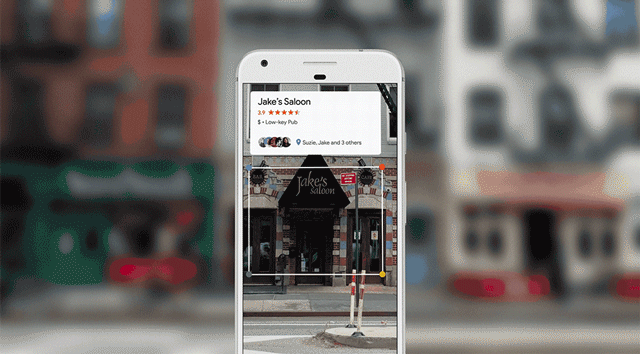
Print media already started to actively incorporate AR into their publications. Esquire Magazine proved this in their 2009 issue when readers were able to scan the paper cover and trigger an augmented reality experience with a very lively real Robert Downey Jr.

No doubt both the magazine’s and Downey’s fans were crazy for this marketing move.
Pepsi too joined the dance and used the augmented reality technology in their marketing strategies. Their AR billboard campaign gathered almost 8 million views on YouTube. Pepsi created an augmented reality experience for those waiting in a bus shelter for the means to get wherever they needed.
2. When and Where AR and SEO Connect
Search Engines Support Visual Search and Will Use AR
All major search engines such as Google, Bing, and Yahoo, employ primary search results techniques. This is how web pages and other contents, such as videos or local listings, are displayed and ranked, depending on what that specific search engine considers to be of most relevance to users. We are talking about organic search here, and not paid search (SEM).
Judging from the continuous growth of augmented reality, it’s no wonder if your website content will soon be crawled, indexed, and ranked higher in SERPs for AR-based content via visual search. Everything from digital content and activity, to offline advertising, physical locations, brand and product photos and images will someday be searched through AR.
Organic search professionals will need to include the augmented reality technology into their content marketing strategies. At least, this is what a forward-thinking SEO and business would do.
Augmented reality is beneficial for brands that are searching and fighting to be first and foremost both in their industry and in SERPs.
For now, Financial Technology a.k.a. FinTech and SEO race to be early smart adopters, although the latter somehow falls behind, although it should be the other way around.
Content Connects the Dots Between AR and SEO
Content is again king. Content is king in AR and VR, just as it is in any other medium. Augmented reality content can take various forms, such as video, social sharing, reviews, 3D objects, usually available all-in-one search engine result page or advertorial.
In order to stand out, content marketers are investing a lot in visual content such as videos, images, and infographics. But it’s time to consider AR tech in your content marketing strategy.
Sporting good augmented reality technology and smartly optimized content will both please your audience and boost your content up in SERPs. This way you encourage your customers to participate in the AR experience by contributing with content in real-time. Augmented reality is where content is not only provided by the brand, but also by the customer, both online and offline, and where positive content probably has the biggest impact of them all.
VR is in many ways similar to AR. Thus we think that many VR statistics and analytics speak for AR, too. When asking users for feedback on what to improve in VR, 55% said more content, and 45% said better quality content.
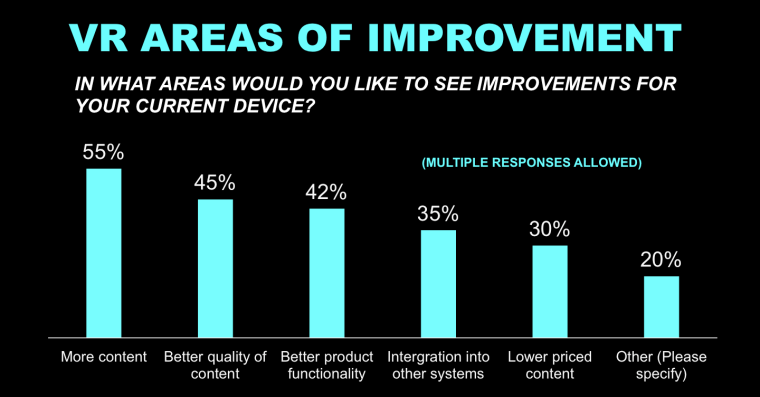
The Impact AR Has on SEO
Mentions, reviews, links, ratings, all in a new form – this is what AR offers to the world of SEO.
Given the novelty and hype of this AR madness, people are naturally drawn to brands who take the risk (or the opportunity) to include AR into their content marketing strategy. This is why AR triggers brand awareness, something many businesses fight for and with.
Augmented reality cultivates a wow-factor. It presents a new search and information-ready ecosystem to organic search professionals.
AR-impacted SEO agencies can get actionable data and deep insight into customer behavior, thus knowing how to launch more engaging and successful marketing strategies across search engines.
Augmented reality isn’t supposed to replace your existing SEO efforts, but to expand your audience and to engage them to an extent they’ve never experienced before.
Talking about the audience, Adobe recently published a survey made on AR app users to see how many fans are there.
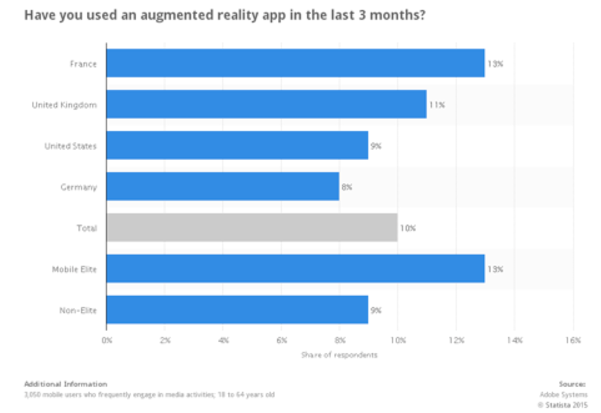
The numbers are in continuous growth, so this is a clear indicator of something that triggers people’s attention and makes them walk on that digital path – use it to drive them to you – as one of your communication and content means.
3. Augmented Reality and Local SEO
Augmented reality is bridging the digital world with the real world. The rise of AR has brought an increased importance to local SEO efforts – e.g. geolocation.
Pokemon Go is an AR-based gaming app, launched in July 2016, and works by the rules dictated by location. Pokemon Go is a location-based game.
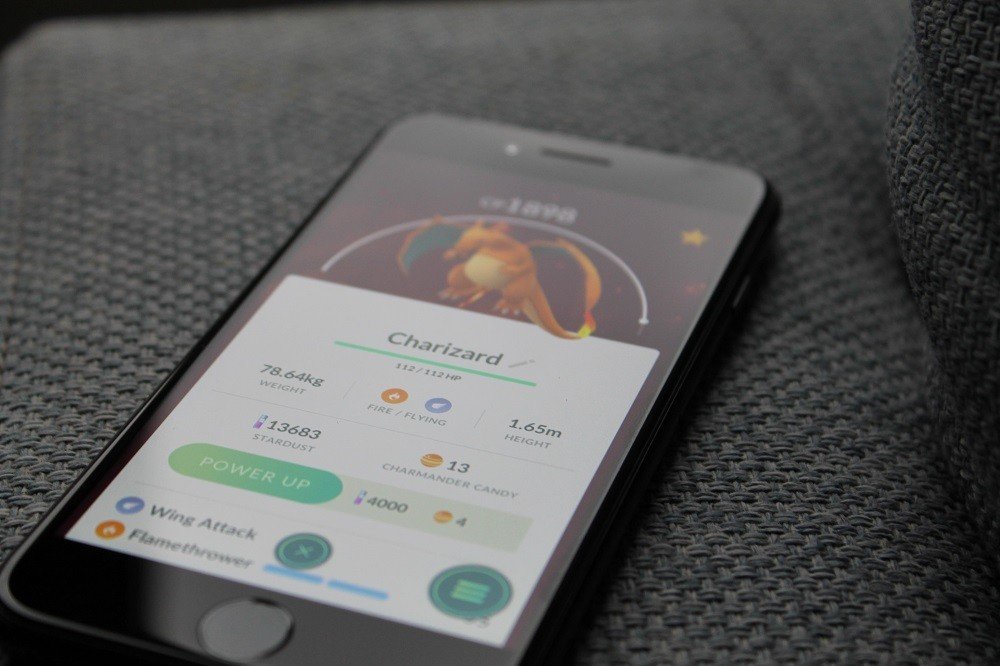
Search marketing and SEO gain useful informational data on the surroundings by deploying AR experiences from their customers. All they have to do is to hold up their phones, scan a section of their world and get optimised information offering anything from cafes, restrooms, ATM mapping, museum, to opening hours, discounts, and job vacancies.
What Is Local SEO?
Local SEO or local search is everything existing in a specific geographical area that is/can be searched and found online. People usually deploy local search when aiming to find some specific information, or want to make an offline transaction (and search online for ATM or bank posts). Local SEO is about the marketers’ efforts to create the perfect means for users to find their business and engage with their brand at a local level.
Local SEO is SEO to the next level. Local SEO helps businesses stand out in the SERPs and get better traction.
In other words, local search is similar to when you look in the yellow pages offline for some kind of information, but instead, it’s conducted online. Examples: “ATM downtown Frankfurt”, “shopping center on Avenida da Boavista”.
Technologies, devices, and concepts such as location-based, geo-targeting, geo-fences, and beacons are big names in local search and SEO.
Local Search Ranking Factors
In matters of local SEO, everything regarding location details has to be updated and accurate – otherwise, the AR user experience may fall flat.
Local SEO makes great use of anything that is both user-generated at a local level, and locally available. It can and will work only with existent surroundings, objects, user feedback inputs, and business information. Nothing more, nothing less, whether you like it or not.
There are a series of local search factors that greatly influence your positioning in the SERPs. Augmented reality apps will use them to the very core, so mind them as they matter both for the present, and for the future.
1. Google My Business Listings: in the AR landscape you could, say, use your phone or wearable device to scan a building or a nearby area and get info on a particular business, images and all, ratings and reviews, and also competitor listings of nearby businesses. This is both compelling and engaging and the audience will be undoubtedly attracted to it. That’s why you need to keep your business details updated and as comprehensive as possible to satisfy your customers’ needs and curiosity.
2. Citations: they are local mentions of your brand name, address, or any other related information, important to augmented reality, in the view of third-party sites known as citation sources. Yelp is one such third-party citation platform that people from San Francisco, New York, L.A., Chicago, and many others often use. Yelp encourages people to share their experience and leave reviews on various types of businesses such as restaurants, shops, clubs, sports centers, beauty salons, home services, and a whole lot more.

3. Reviews: they are a big part of local SEO and also for location-based AR apps. They are user-generated, hence 100% authentic and organic. With AR apps users will get real-time reviews on restaurants, stores, and whatever other building they would hover on with their device.
The review system is amplified with the AR technology. Businesses should now more than ever increase positive feedback so to maximize and secure sales.
Reviews have the power to influence foot traffic to your local business. But brands should for all intents and purposes first deliver impeccable services and product experience to customers, and only after that good word of mouth will be spread.
Besides, this augmented reality twist on reviews could raise awareness among business owners to implement or improve their negative customer complaint management system, as reviews of all types appear in real time and can harm their reputation.
4. Geo-targeting. Similar to roaming messages working on the geo-localization principle, imagine getting push notifications on your AR app when connected and viewing the street with a wearable device, and being informed of nearby discounts, partnering brands with the one you’re in at the moment and their services. All through engaging theatrical or motion experiences.
Yet location targeting doesn’t always imply geo-localization. It can also be deployed using the marker-based type of AR, with objects coming to life, switching from offline customer experience to online customer experience. Or intertwining them.
Local SEO, Local AR, and Content
Local AR regards virtual annotating experiences triggered by location positioning of a user with an AR app on their devices.
Local AR needs geotagged content, something Google already owns if we think of Street View imagery and their impressive place database (Google My Business Listings is one of them, yes!). Thus, local data businesses will already be one step forward in the game as they will provide local AR apps with the info they need. A good example is Yext, a platform that puts businesses on the map with relevant details and information, such as contact details, listings, reviews, analytics, etc.
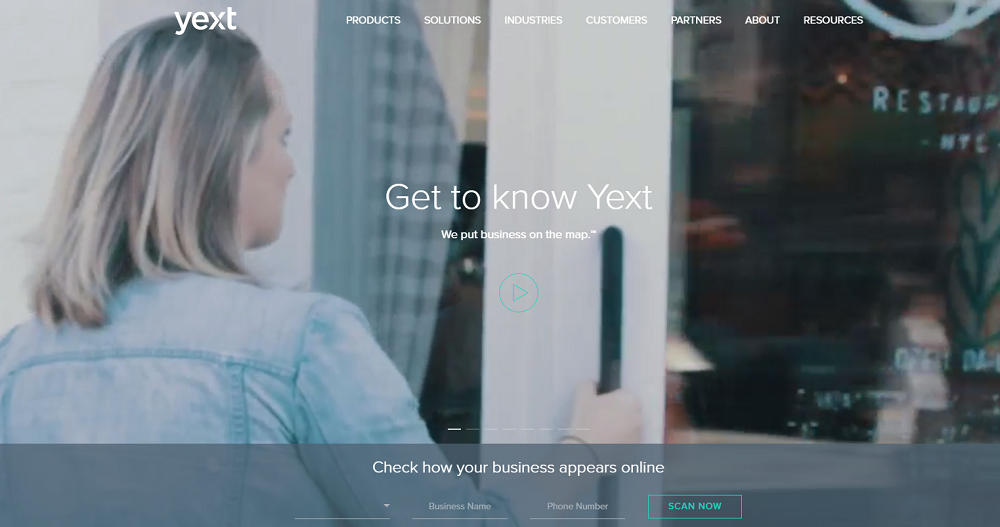
Google Earth is also an enormous place database with everything from satellite imagery, maps, terrain, 3D buildings to relief in the oceans and galaxies in the outer space. Augmented reality will undoubtedly make use of this data. Humans already do it and, many times, this data is life changing. A fit example is Saroo’s search of home, where he succeeded to find his long-lost family and place of birth.
How Does SEO Benefit from the Rise of AR?
With the help of augmented reality, SEO will better serve clients’ needs and help them make decisions on anything at another level of ease. AR can provide better user experience and grant more information-rich services. Just as it does here, with a marker-based AR app for scanning cars and finding the necessary information and specifications before purchase.
Jump into the driver’s seat of your dream car and experience it in 360, or simply satisfy your curiosity about the cars you pass by in the street! Blipp any vehicle make/model in the entire US market to unlock AR content.
Posted by Blippar on Tuesday, June 6, 2017
By improving customer experience, your clients will find the information they need faster, take decisions easier, and make transactions at a greater speed. When playing after AR rules, local search gets a facelift. Initially, offline shopping behaviors can turn into compelling online engagements.
What Do Experts Say About Augmented Reality and SEO
Blippar, one of the biggest players in the AR industry, said that augmented reality boosts user engagement, and consequently dwell time is increased.
The augmented reality platform raised $45 million in 2015, giving it a huge incentive to advance AR to the next level.
Ori Inbar, founder of Super Ventures, a VC company specializing in VR said: “Augmented reality is the next mobile computer, the next OS, the next social platform. The smartphone is dead; it just doesn’t know it yet”.
Tim Cook, Apple CEO, regards AR as being a huge opportunity in the digital landscape: “I regard it as a big idea like the smartphone. The smartphone is for everyone. We don’t have to think the iPhone is about a certain demographic, or country or vertical market; it’s for everyone”.
Notable entities invest heavily in the research and development of AR. Although Google Glass had a false start, Tango holds all the aces and doesn’t seem to change a bit. Facebook is building AR and VR glasses, Snapchat wins with Spectacles – playful goggles that capture video that can be shared via Snapchat, Apple intends to incorporate AR on smartphones. Most of them invest in many AR and VR apps and tools.
Google and Augmented Reality
Google AR Activity and Worldwide Recognition
Google plays an important part in the development of AR and VR. Google noted on their blog that “we’re making investments in the core technologies that enable VR and AR, and in platforms that make them accessible to more people”.
Google is an active player in the AR business, making big moves in AR with projects such as Tango, VPS, and Google Lens. And there’s a lot at stake for them. Check the video below to better grasp what’s the whole thing with Google, AR, and search.
It is clear that Google is investing both time and money into this new digital technology and many might wonder why. At Google I/O ’17, Clay Bavor, VP of Virtual Reality at Google, wanted to make it clear and put their AR activity in a bit of a context.
At a quick search on “Google about AR” results were pretty meaningful. The big search giant is far from being reluctant to AR.
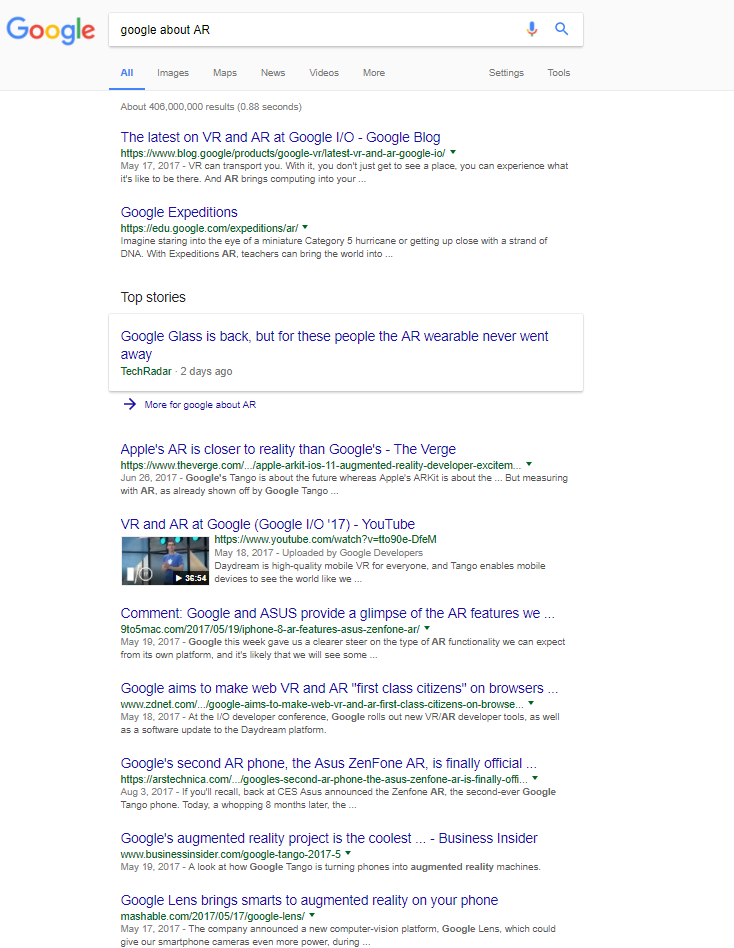
Obviously, given such a rich AR and VR activity, Google got even awarded for their research and development, notably in 2016 and 2017. In 2016, they won 3rd pace for putting VR for the masses in a cardboard box, and in 2017 they won 1st place for developing a photographic memory.


Google Glass: To Be or not to Be – That Is the Question
Google made a first step in the AR arena in 2013, when it launched Google Glass, a special goggle-like device that employed AR overlays to inform the user of various things (on which I will expand later). Eventually it ceased production in 2015 and that’s why some call it a fake start. But the idea lived on with a new gadget, Google Enterprise Edition, similar to the first edition, but addressing a special niche – the work environment.
Given that most of the SEO efforts have Google as a center target, it is important to see how and how much Google supports and partners the evolution and development of AR. Whether we like it or not, we marketers all have to play by the Google rules. Thus, it’s better to be one step forward in the game and be ready and informed on the AR boom.
Going back to our sheep, in 2013 Google launched a first Google Glass edition called the Explorer Edition. It wasn’t the final product or consumer version, but one that could be tested by users from whom to get actionable feedback. Feedback would have further helped develop the software, shape, and all of Google Glass.
Initially, the Explorer Edition included 7 functionalities:
- Take pictures;
- Record a video;
- Get directions;
- Send a message;
- Call someone;
- Google+ hangouts;
- Google.
At that moment, the list of things that it could do was rather limited, yet it targeted to be a promising paradigm tool (something like an android phone with no apps, on your face).
Although photo, video, navigation (walking, driving, biking navigation), call, message, and Google search were awesome stuff to play with on Explorer Edition, more was needed. That’s why a Google Glass Explorer community of developers formed up, with all them looking to further develop and create new apps and functionalities for this device.
Google Glass Enterprise Edition on the other hand, seems to have more success and that the odds will be in its favor. Intended for work environments, and not for the regular consumer, it addresses businesses with hands-on workers and experiences.
Tango Winning the Dance Floor
Simply put, Tango is Google’s augmented reality platform. The Tango technology is an AR scanning one and it has three functions: motion tracking, depth perception, and area learning. At Google, Tango is for AR what Daydream is for VR. Google took care of that.
Tango has been used for both AR and VR, but primarily it’s the core technology behind Visual Positioning Service (VPS), Expeditions AR, and other AR devices.
2017 came with a promise from Google experts – that of a new AR app promised to be released this fall. It uses Google’s Tango technology to map the physical interiors (say, a classroom) and place 3D objects in AR.
Expeditions AR has been introduced into a special educational program supported by Google, called the Pioneer Program, where AR lessons are taught to American students inside classrooms.
Yet rumor has it that Tango is or is going to be soon left behind, as Apple ARKit gains ground both in announced product concept, and in predicted fan base. Some say that “Google’s Tango is about the future whereas Apple’s ARKit is about the present” but it’s better to let time and numbers tell the tale.
Virtual Positioning Service (VPS)
This year, Google’s I/O conference shared an important AR piece of news. Tango gets a new Visual Positioning Service (VPS) that works as a better performing, highly accurate form of GPS.
VPS, called the new GPS, is taking the reins from where GPS stopped. It helps devices quickly and accurately understand their location indoors. GPS takes you to the location, but VPS can take you to a specific item from a store or location, namely performing indoors.
Blippar location-based AR tech is sporting some new prototype of VPS, called UVPS, that is Urban Visual Positioning System.
Blippar's latest development in computer vision is a breakthrough in location-based augmented reality tech with an accuracy almost double that of GPS! Take a look for yourself
Posted by Blippar on Wednesday, August 9, 2017
Not to forget about Google Lens, update helping Google use AR to its visual search purposes.
Google Supported AR Devices
Google supported the launch of two mobile phone models that support Tango and AR in general, namely partnering the Asus and Lenovo brands.
Asus ZenFone AR is the second-released phone suitable for both Tango and Daydream, granting his success over his predecessor. To exemplify what you can do with it, ZenFone allows you to scan a 3D map of your home and, while shopping for furniture, you can scan that item and place it in your home to see if it fits and suits. One way or another, ZenFone hypnotizes you with what it can do.
https://www.youtube.com/watch?v=HF5KU64JRxc&feature=youtu.be
Facebook and Augmented Reality
Facebook announced this year at the F8 developer conference that they plan to launch a new platform for coders to build AR apps in addition to Facebook’s core service. It is open to a limited number of developers and now it’s in beta mode. There’s no date available yet as to when the product will be released.
The social network giant bets on its own AR strategy, being confident that it will shine through in an already-crowded AR market. Mark Zuckerberg says that Facebook will help people get used to AR first through their phones, and then through other devices.
Facebook is known for making research in VR and building its Oculus Rift VR headset, but not so known for AR. Yet the SERPs displayed when searching about Facebook and AR are both meaningful and surprising.
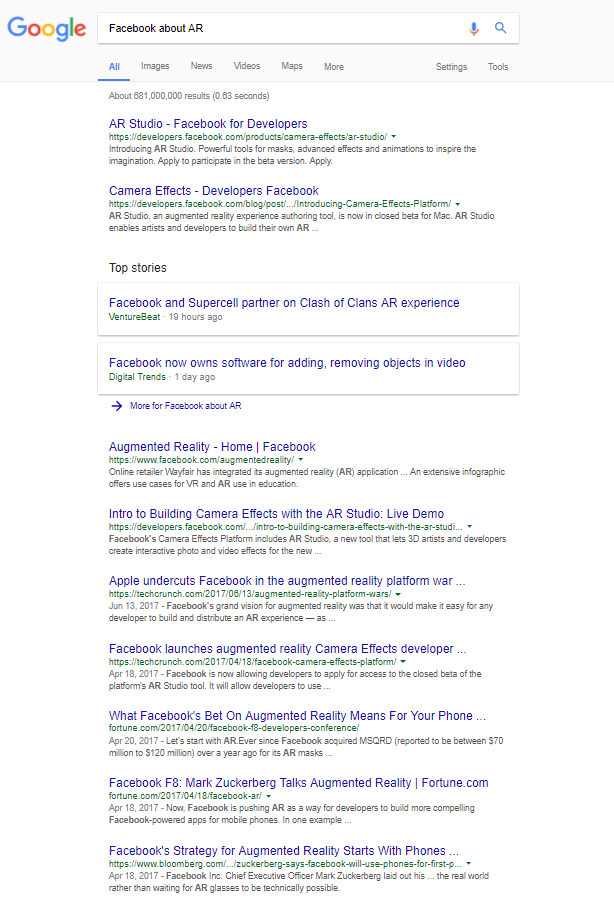
While most of the other big tech players are using AR to turn static objects into a live 3D experience, Facebook would bet money that customers need something more personal, therefore empowers the smartphone camera and makes human faces the trigger for AR experiences.
Facebook-powered apps – Facebook, Messenger, WhatsApp, and Instagram – will all meet new camera capabilities in terms of AR. In short, Facebook left us with two things in mind: the camera is everything, and they’re poised to make AR huge.
And Facebook literally bets their money on AR, together with VR, by investing heavily in this child star tech.

What Is AR to Facebook?
AR is for Facebook the trigger to social communication, the social software that helps people build their relationships online.
AR could also help Facebook prevent inappropriate videos from being posted on the platform, and no longer be depending solely on humans. Facebook announced, at their big developer conference of 2017, that they plan to monitor violence on the platform and most probably they will use AR for this purpose, too.
How Facebook Plans to Bring Novelty in AR
Facebook’s platform for AR developers and projects is similar to Google’s Project Tango, only that they didn’t mention anything about 3D motion trackers or depth sensor that need to be installed on Android supported phones. They just stated their intention of turning the smartphone camera into an AR full-stack device, without the fuss of designing custom hardware or phones for their new platform.
Besides, Facebook believes the augmented reality glasses’ popularity is to fade sooner than expected.

Snapchat and Augmented Reality
No doubt everybody is familiar with the annotating camera effects Snapchat uses on their app. Basically, the augmented reality effects they use on people’s faces and surroundings represent more of 50% people associate with Snapchat when somebody utters the brand’s name.
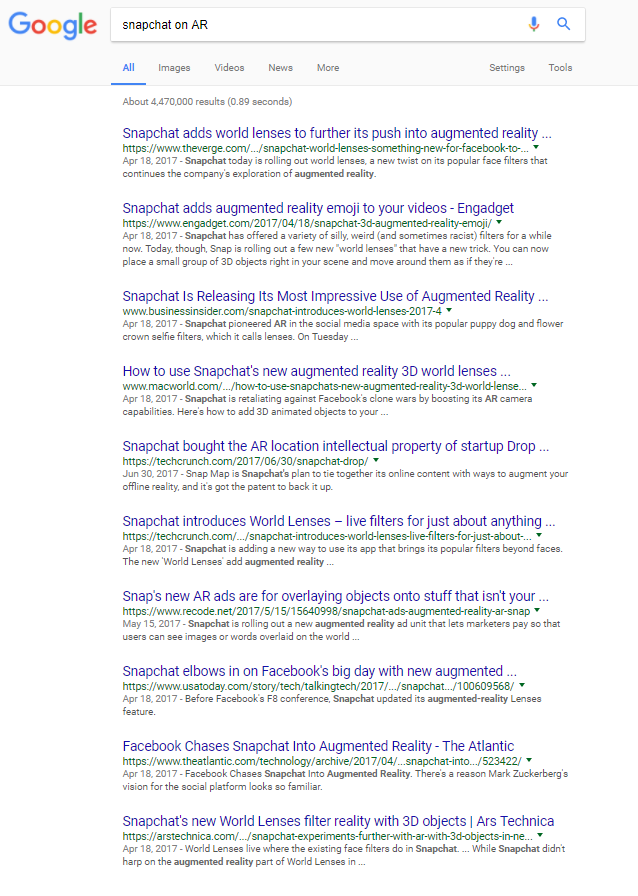
Apart from that, they’ve successfully launched the Oculus special AR glasses in 2016 and people went crazy on it.
In April 2017, Snapchat made an update and added world lenses for a further leap into augmented reality. Its AR capabilities can add 3D animated objects to your Snapchat messages.
Apple and Augmented Reality
As usually, Apple comes late but steals the show by upgrading and outwitting everything their competitors have already done. Thus Apple is poised to outstrip Facebook in their AR plans, by offering a more enticing and convenient option for AR developers to make their apps available to the audience.
Apple is set to smash competition with a brand new relaxed vision on AR. Apple’s advantage in the battle is simple and clear cut: while Google Tango needs special hardware, ARKit requires developers and users to only have a recent iOS device.
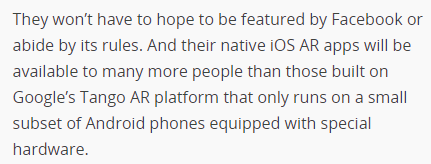
Techies like to say that even though Facebook is the most powerful app in the world, it’s still just an app on Apple’s operating system. Pretty nasty, huh?
On another train of thoughts, Tim Cook let us understand that he prefers AR over VR and considers the former to be more commercially viable as people can still interact and be present among others as opposed to VR, where a screen is wrapped around your face and you immerse yourself into a brand new world and forget about the real one.
ARToolKit is the place designed by Apple where AR advocates create, gather, and store AR applications.
All things being said, AR will take longer to flourish to its full potential. It needs time, money, and a lot of patience and skill.
Besides, AR comes with a high cost of production, hence the small number of brands leveraging this technology in their marketing strategies for the time being. Yet businesses work hard and publish job listings on AR developing positions to make the augmented reality dream come true.
What the SEO Industry Should Do Next
AR Current Status and Future Follow-up
Augmented Reality enables digital material to be superimposed on any physical object. That we know. But what about what we don’t know yet?
Today AR apps can do the following: gaming and play (3D games triggered by scanned objects), media/advertising (print, TV, and product packaging), instructional (education, blue-collar industry, medicine).
To list just a few facts about augmented reality and its current status, here are some details like number of released apps, devices, and investments in AR.
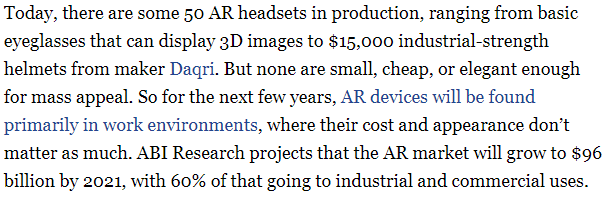
AR devices don’t appeal yet to a large mass of consumers but find a home more in the work industry environment.
Besides the above-mentioned already existent AR features, the future apps of this new technology will also include visual search, navigation, and discovery, social networking.
Soon, this annotated world will walk hand in hand with SEO marketing in a way never seen before: bold innovative promotions, fresh inbound marketing campaigns, and a noteworthy updated user experience will be the small talk of the AR world.
Action Time and Mindful Steps to Take
Augmented reality aka search in an annotated world won’t wait for you.
The AR landscape shows signs of becoming mainstream, therefore it’s important that you join the dance as soon as possible if you want to keep your business up-to-date and attractive as the marketing world faces its next massive shift.
Although your business is small you need to be ready for the AR boom; when it becomes trending and indispensable, you risk to fall flat with your marketing strategy and be left behind. Be equipped.
Overlay virtual imagery specific to your brand on the real world that both you and your customers share and live in. Seek to be a frontrunner in deploying this technology.
“Then what should I do?”, might someone ask. We believe a first step is to be inquisitive – download AR apps, try them out, see what works and what doesn’t, and understand how it is for companies to engage with the audience through augmented reality. In addition, keep yourself up-to-date with the development in the AR industry.
Then you should go deeper and more analytical.
Pay attention to your citation profile. Local citations are a key ranking factor in search engines. The richer, the better. It will appear in review sites, thus in the SERPs to people’s queries. These sites play an important role in Google results, thus in organic search. There are more chances for your business to be found by your targeted audience when entering queries.
Reviews are gaining ground nowadays and, being a user-generated SEO, they fit perfectly in the AR landscape. As augmented reality will keep growing, so will the influence of reviews. Imagine fresh star rating left by a customer dining at the same restaurant as you do popping up on your screen and informing you of the restaurant’s services. Wouldn’t it be useful?
Check to see if you have Google My Business Listings, and then make sure you provide a rich array of good-quality photos and updated business and contact details. This is most often the go-to point of information. It’s supported by Google, a huge supporter of the AR evolution; so secure your spot and feature relevant and updated brand info such as addresses, opening hours, phone numbers, business updates, and images.
Location, because AR literally depends on real world location, as opposed to its twin sister – virtual reality. Similar to roaming text messages that you get when entering another country, AR aims at making the audience aware of close-by deals and businesses with pop-up messages projected on real world ground and seen with an AR supported device.
If already engaging with the augmented reality technology, mind the following steps:
- Plan constant updates to keep your AR experience fresh and relevant;
- Use social media to raise awareness about your brand using AR;
- Create engaging AR campaigns suitable for your brand advocates;
- Enhance your audience’s user experience by adding AR to printed literature such as business card, banners, brochures, and leaflets.
Designing and implementing AR apps in your SEO marketing strategy means more than just having fun. Of course, you can find a lot of helping tools and app out there. For instance, you can check out leaflets or brochure templates online. Yet, you should primarily start with a clear idea of how your users are going to benefit from such technology as AR. Your business should also check an open team mindset on their to-do and must-have list. If you want to succeed with AR, you need impeccable collaboration between computer scientists, designers, developers, and marketers. A strategy for integrating this new technology into the CDJ is not an easy task, you know …
Now What?
Pokemon Go proved the world that not only VR is focused on gaming, but that also AR can do the job. And that not only VR can be fun and engaging, but AR too.
Things are moving, and they’re moving in the right direction. The Future of StoryTelling Summit and community is bringing techies, marketers, and talents together to discuss the present and future of storytelling in a world overflowing with digital inventions and once-SF now possible technologies. Once again, content is king. People and technologies along will always cherish its power and its unquestionable evergreen status. The way we interact with content and stories has gone unchanged for ages.
People want to be part of the story and message, and augmented reality grants them this wish.
So are people really going to buy the idea? Are they going to use AR apps and hold screens in front of their eyes all day long? Probably not, not even digital natives. It should make everything easier, more fun, more convenient, and not bring a plus of a burden. That is why AR is in a continuous change and development; tech giants want to make it something that is piece of cake, and a day-to-day necessity and joy. And most probably they’ll succeed.

 Site Explorer
Site Explorer Keyword tool
Keyword tool Google Algorithm Changes
Google Algorithm Changes

Such a great article, Cornelia! Worth a read!
Our digital marketing team at SE Ranking totally agrees with such a forecast. Moreover, we’ve researched the voice search influence on SEO for one of our blog post content. What’s in the bottomline – we have to get prepared for AR and voice search as soon as possible.
Glad you liked it, Lauren! AR has a huge potential indeed; I was interested on the Voice Search topic as well. I’ve detailed some more here: https://cognitiveseo.com/blog/11995/voice-search-effect-on-seo/
Hi Cornelia,
Great post! I haven’t even considered it for seo for our site, and we’re in an extremely related industry. That goes to show. Even for a tech based blog, you have to keep on your digital toes.
This is indeed a very interesting topic to explore.